New hikers require essential gear for a safe and rewarding experience. Start with navigation tools like smartphone apps or a GPS device, complemented by a compass and map. Layered clothing is essential for temperature regulation, focusing on moisture-wicking base layers and insulated jackets for warmth. Choose appropriate footwear based on trail difficulty, ensuring a good fit to prevent blisters. Manage hydration with bladders or bottles and supplement with purifiers for natural water sources. Packing dense snacks and a well-stocked first aid kit is critical. Weather preparedness, including a rain jacket, enhances protection. Explore more for an extensive hiking plan.
Key Takeaways
- Use navigation tools like AllTrails or a compass for safe and confident hiking.
- Wear layered clothing to adapt to changing weather conditions effectively.
- Choose the right footwear to prevent discomfort and injury on trails.
- Carry adequate water and purification methods for hydration and safety.
- Pack essential emergency gear and a first aid kit for preparedness.
Navigation Tools
In the domain of hiking, possessing effective navigation tools is essential for new hikers to secure both safety and confidence on the trails. For tech-savvy adventurers, smartphone apps such as AllTrails and Gaia GPS offer a wealth of trail maps and tracking features. These apps provide real-time location data and route planning, though their reliability may falter in harsh conditions like remote areas with poor signal or extreme weather.
Consequently, a robust alternative, such as the Garmin GPSMAP 67, is recommended. This device is specifically designed for rugged outdoor use, with button-operated functionality that guarantees durability and precision even under challenging circumstances.
Equally important is mastering traditional navigation techniques. Carrying a compass alongside a paper map remains an indispensable practice. Compass skills allow hikers to orient themselves accurately, securing safe passage through unfamiliar terrain.
Paper maps offer a thorough overview of the landscape, and storing them in a Ziploc bag protects them from environmental damage. Integrating these traditional methods with modern technology creates a balanced navigation strategy, empowering new hikers to traverse trails with assurance, regardless of external conditions.
This dual approach fortifies one's ability to handle unexpected challenges on the path.
Essential Clothing
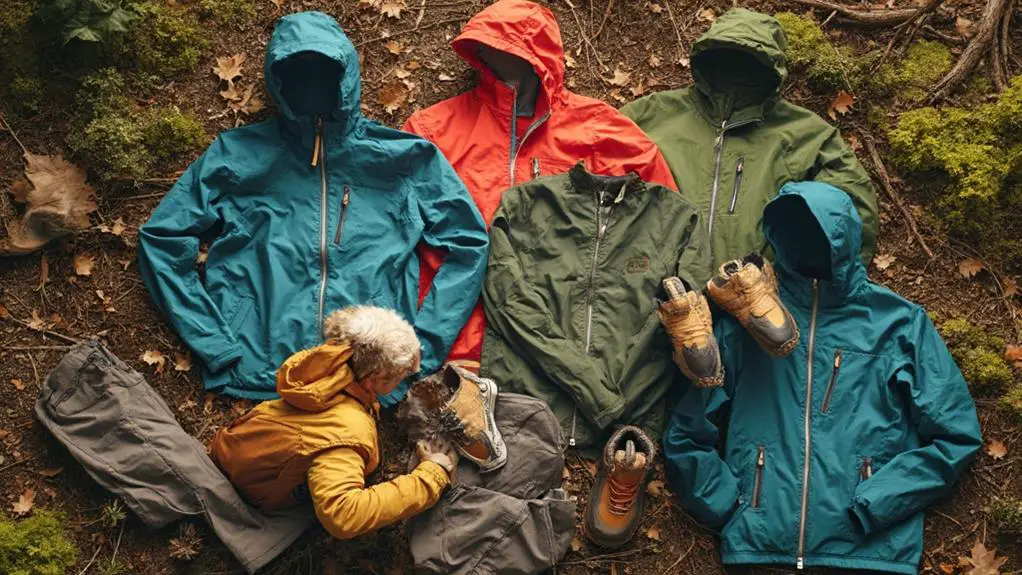
When starting on a hiking adventure, selecting the right clothing is essential for adapting to weather variability and ensuring comfort.
Begin with moisture-wicking base layers made from synthetic or Merino wool to effectively manage sweat and maintain body temperature, adding mid layers like fleece for insulation as needed.
Additionally, prioritizing footwear that offers a snug fit and adequate support is vital for preventing blisters and providing stability on diverse terrains.
Layering for Weather Variability
Effective layering is vital for hikers to adapt to the ever-changing weather conditions encountered on trails. Mastering layering techniques facilitates ideal temperature regulation, essential for comfort and safety.
Begin with a base layer crafted from moisture-wicking materials, such as Merino wool or synthetics, to efficiently manage sweat and maintain a stable core temperature. This foundation is pivotal in preventing hypothermia and overheating.
The mid layer is your primary source of insulation. Select stretchy materials like fleece or lightweight jackets that accommodate movement and adjust to fluctuating temperatures. These layers trap heat while allowing freedom of motion, ensuring that you remain comfortable as conditions change.
For added warmth, particularly during evening hikes or at higher elevations, an insulated jacket is indispensable. Opt for packable down options that can be easily stowed in your backpack yet provide significant warmth when temperatures drop unexpectedly.
Moisture-Wicking Fabric Benefits
As hikers prepare for varying weather conditions with effective layering, understanding the role of moisture-wicking fabrics becomes vital. These fabrics excel in moisture management by swiftly drawing sweat away from the skin. This function not only enhances comfort but also considerably reduces the risk of chafing and irritation. The advanced fabric technology employed in these garments often includes synthetic materials like polyester or nylon, which dry faster than traditional cotton, making them indispensable for trail adventures.
| Fabric Type | Key Benefits | Ideal Conditions |
|---|---|---|
| Polyester | Quick-drying, moisture-wicking | Warm, humid climates |
| Nylon | Durable, moisture-wicking | Varied weather |
| Merino Wool | Natural odor resistance, breathable | Cool to moderate temps |
| Blends | Enhanced comfort, moisture-wicking | All conditions |
The breathability of moisture-wicking fabrics facilitates effective airflow, essential for regulating body temperature and preventing overheating in warm or humid environments. Additionally, many of these garments are treated with antimicrobial properties, reducing odor and extending wearability—an important feature for multi-day hikes. Incorporating moisture-wicking base layers into a layered clothing system is vital for maximizing comfort and performance. By leveraging cutting-edge fabric technology, hikers can guarantee they remain dry and comfortable, making their outdoor experiences more enjoyable and successful.
Footwear Fit and Comfort
How can hikers guarantee their journey is as comfortable as it is adventurous? Selecting the right footwear is paramount, beginning with a meticulous fit assessment. Proper footwear fit guarantees comfort and prevents injuries; hiking shoes should be snug yet not restrictive, with a thumb's width of space at the front to avert toe bruising during descents.
The type of hiking you plan to undertake dictates the choice of footwear materials: trail running shoes offer agility and breathability, ideal for fast-paced hikes, while robust hiking boots deliver necessary ankle support and durability on rugged terrains.
Breaking in new footwear is critical; wear them on short walks or around the house to mitigate the risk of blisters and discomfort on longer treks. Complement your shoes with moisture-wicking socks like those made from Merino wool, which help regulate temperature and keep feet dry, reducing the likelihood of blisters.
Additionally, confirm your footwear features aggressive tread patterns for excellent traction, an essential attribute for maintaining stability on varied surfaces, especially in wet or slippery conditions. By prioritizing fit and comfort in footwear, hikers can enhance their outdoor experience, guaranteeing both safety and enjoyment on every trail.
Footwear Selection
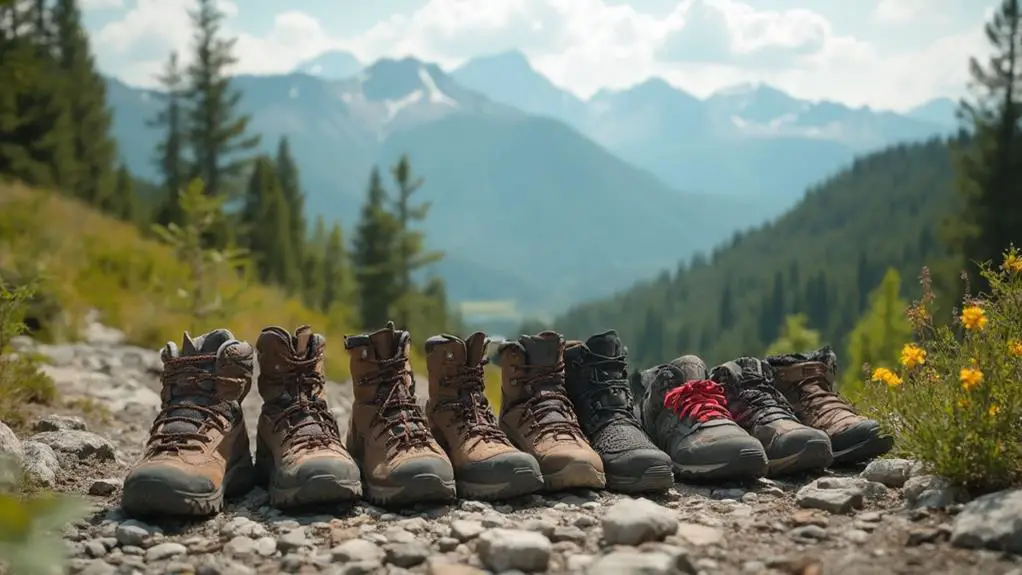
Selecting the right footwear is a significant decision for any new hiker, as it directly impacts comfort and safety on the trail. When choosing hiking shoes, it is essential to take into account the materials used in their construction.
Opt for shoes crafted from breathable, moisture-wicking materials, which help keep feet dry and minimize the risk of blisters. These materials promote air circulation, preventing overheating during vigorous hikes. Additionally, prioritize waterproof footwear options to protect against wet conditions and unexpected weather changes. Waterproof membranes, such as Gore-Tex, are imperative for keeping feet dry when traversing muddy or rainy terrains.
Moreover, the type of hiking you plan to undertake determines the suitable footwear. For rugged and uneven trails, hiking boots with robust ankle support and superior grip are recommended. They offer stability and protection against potential injuries.
Conversely, for lighter, less technical hikes, trail-running shoes provide a more lightweight and agile option. Regardless of the style, make certain your footwear choice features a good grip and traction to navigate varying surfaces safely.
Remember to break in new footwear before starting longer hikes, and always select a fit that allows room in the toe box for swelling, enhancing comfort and performance.
Hydration Options
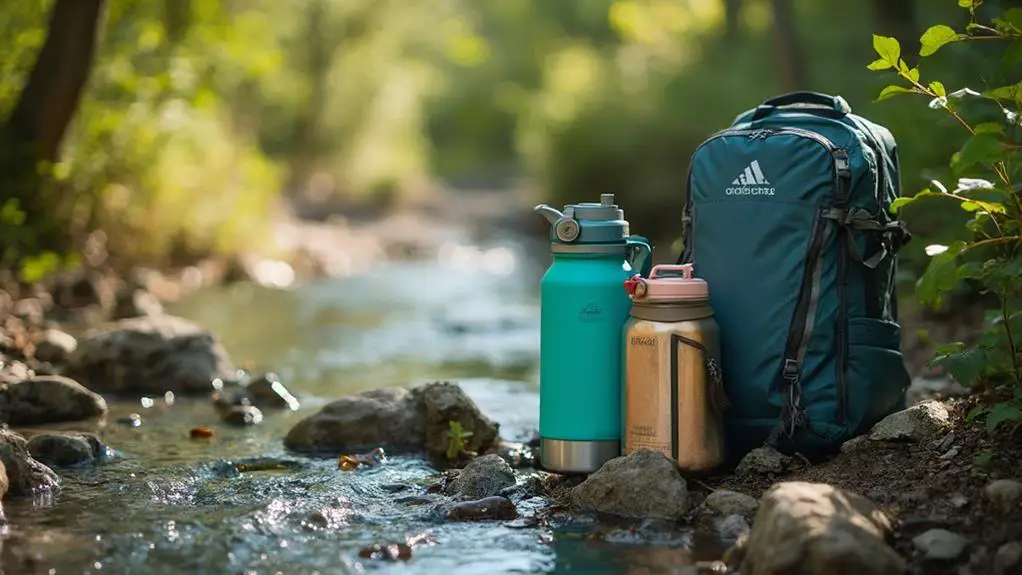
With your footwear selection optimized for comfort and safety, it's equally important to address hydration strategies on the trail. Carrying sufficient water is essential, and a general guideline is to have at least 1 liter per person per hour of hiking. This guarantees you remain hydrated, particularly in hot conditions.
For convenience, a hydration bladder offers a hands-free solution, allowing you to sip water without breaking stride. However, it's vital to monitor your water intake, so keep track of your consumption to avoid running out unexpectedly.
For those who prefer simplicity, lightweight water bottles like Smartwater are an excellent alternative. They are not only easy to pack but also compatible with popular water filters such as the Sawyer Squeeze. This combination facilitates quick and effective water purification, guaranteeing access to safe drinking water when hiking in remote areas.
On longer or more strenuous hikes, it's advisable to carry at least 3 liters of water to mitigate the risk of dehydration and maintain energy levels.
Always pack water purification methods like tablets or filters to treat natural water sources, enhancing both safety and self-reliance on the trail.
Nutrition and Snacks
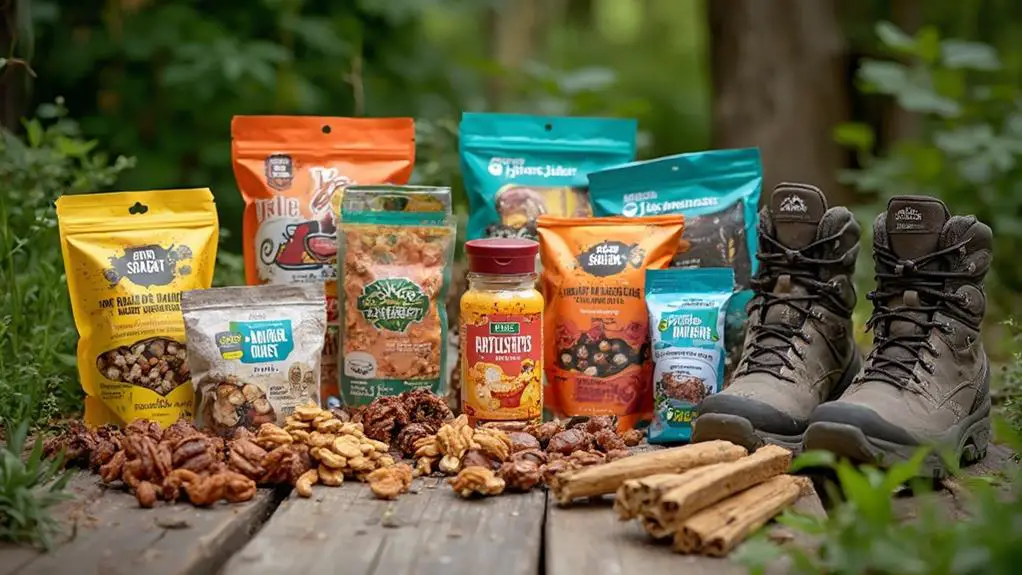
When starting on a hiking adventure, it is essential to prioritize nutrition and hydration to maintain energy and endurance.
Pack nutritionally dense snacks like salted nuts, dried fruits, and energy bars that offer a balanced mix of carbohydrates, proteins, and fats, ensuring sustained energy levels.
Complement these snacks with at least 1 liter of water per hour and consider adding electrolyte supplements, such as sugar-free NUUN Active Tabs, to effectively replenish important minerals lost during physical exertion.
Energy-Boosting Snack Options
For new hikers looking to maintain energy and stamina on the trail, selecting the right snacks is essential. An understanding of nutrient timing and snack variety can greatly enhance endurance during hikes. Nutritionally dense snacks, such as salted nuts, fruit, and energy bars, are excellent choices for providing necessary sustenance.
These snacks offer a balanced mix of carbohydrates, proteins, and fats, which are important for maintaining energy levels and focus. Integrating a variety of snacks guarantees that you are not only meeting nutritional needs but also keeping your palate interested, which can be a morale booster on long trails.
Greenbelly meals and Muir Energy Gels are convenient, high-calorie options that are easy to pack and quickly accessible when energy levels dip. These products are designed to deliver an immediate boost of energy, making them ideal for intense hiking sessions.
It is recommended to carry at least 200-300 calories per hour of hiking, adjusting based on the trail's intensity and duration. Additionally, packing resealable bags for trash management is essential. This practice guarantees a clean hiking environment, allowing you to enjoy your energy-boosting snacks responsibly.
Hydration and Electrolyte Needs
Hydration is a cornerstone of successful hiking, with an essential guideline being an intake of at least 1 liter of water per person per hour to prevent dehydration and maintain energy levels.
To optimize hydration strategies, it's essential to understand the role of electrolytes in your overall performance. Electrolytes, such as sodium, potassium, and magnesium, help regulate fluid balance, muscle contractions, and nerve functions, all important during physical exertion.
For effective hydration strategies, consider incorporating electrolyte supplements into your routine. Products like NUUN Active Tabs can be dissolved in water to replenish lost electrolytes, particularly in hot conditions or during intense hikes. This prevents cramping and fatigue, guaranteeing sustained physical output.
Additionally, carrying a reliable water purification method, such as the Sawyer Squeeze Water Filter, allows access to clean water from natural sources, crucial for long treks where water availability might be limited. This ensures you can maintain adequate hydration levels without carrying excessive weight.
While the importance of water and electrolytes cannot be overstated, the combination of a strategic hydration plan with electrolyte management will greatly enhance your hiking experience and support your body's needs on the trail.
Easy-to-Pack Food Choices
Packing nutritionally dense snacks is significant for maintaining energy and stamina during hikes. A diverse snack variety, including salted nuts, fruit, and energy bars, guarantees hikers receive sustained energy and essential nutrients necessary for the demands of the trail.
These snacks are compact and lightweight, making them easy to pack and carry without adding unnecessary bulk. For longer excursions, consider incorporating Greenbelly meals and Muir Energy Gels, which provide balanced nutrition in a convenient, easy-to-pack format. These solutions are designed to keep hikers fueled over extended periods, important for maintaining peak performance.
Portion control is equally important to prevent overconsumption and manage energy levels efficiently. Utilizing resealable bags not only helps maintain food freshness but also aids in controlling portions. This method facilitates easy trash management, aligning with the Leave No Trace principles.
Electrolyte chews are another practical addition to your hiking nutrition plan. These compact chews effectively support hydration recovery by replacing lost electrolytes, helping to prevent fatigue during strenuous activities.
Always consider the intensity and duration of your hike when planning food and water intake, aiming for a minimum of 1 liter of water per person per hour to maintain hydration.
Emergency Gear
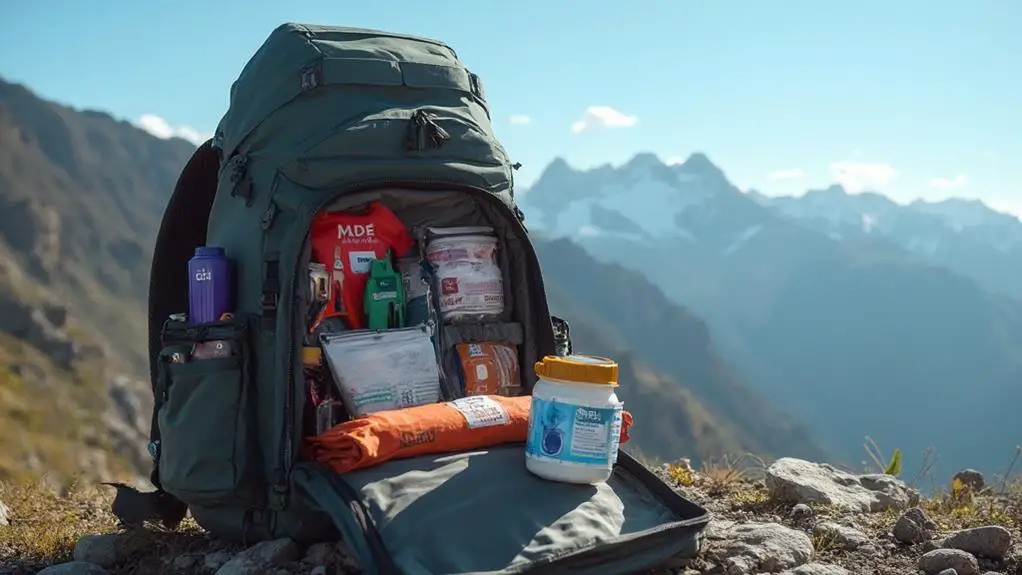
Starting on a hiking adventure requires more than just enthusiasm; it necessitates a well-thought-out collection of emergency gear to guarantee safety and preparedness in the wilderness.
Essential to survival strategies is a Mylar blanket or emergency bivvy. Weighing less than 4 ounces, this compact item provides warmth and waterproof protection, proving indispensable during unexpected overnight stays.
Equally important is a whistle, a simple yet effective signaling device. Lightweight versions are available for under $4, and blowing it three times can alert others to your location in an emergency.
To maintain visibility, especially if your hike extends into the evening, a headlamp or flashlight is indispensable. These tools guarantee safe navigation in low-light conditions, preventing accidents.
Additionally, carrying emergency water purification methods such as Aqua Mira drops or iodine tablets is essential. These solutions provide safe drinking options from natural water sources, securing hydration—a fundamental element of survival.
In terms of gear maintenance, duct tape and leukotape are critical additions. They offer quick fixes for gear issues and blister care, illustrating the importance of being prepared for the unexpected.
This thorough approach guarantees both readiness and resilience on the trail.
First Aid Kit
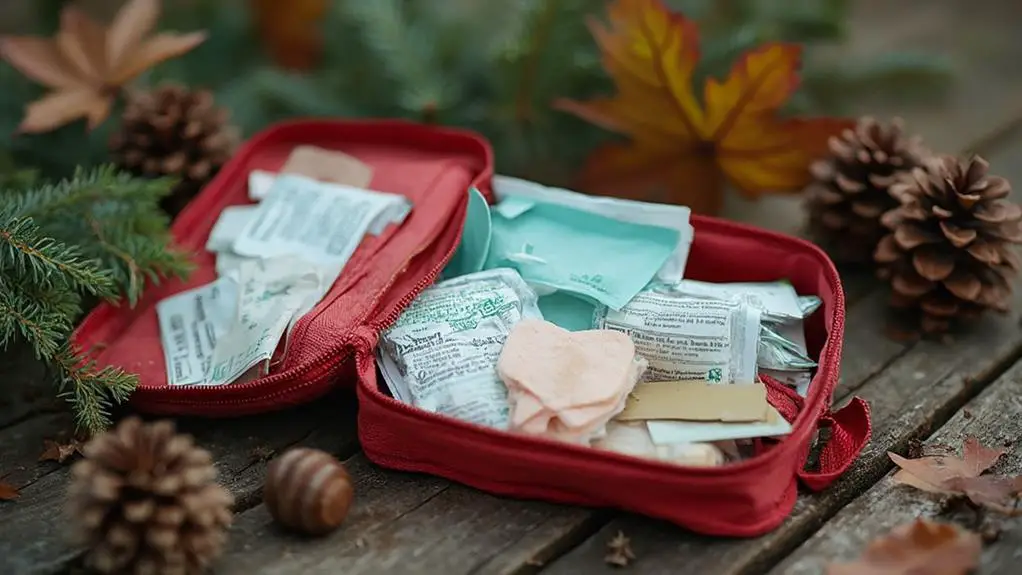
A well-prepared first aid kit is an indispensable component of any hiker's gear, containing essential items such as adhesive bandages, antiseptic wipes, gauze pads, and pain relief medication to tackle common injuries and discomforts.
Customizing your medical kit according to your hiking needs, including blister treatments and emergency supplies like a whistle and Mylar blanket, can greatly enhance your readiness for unexpected situations.
Regularly checking and restocking your kit, and considering the inclusion of pet-specific items for those hiking with animals, guarantees thorough preparedness and safety on the trails.
Essential First Aid Supplies
Equipping yourself with an extensive first aid kit is an important step in preparing for any hiking adventure. A well-stocked kit guarantees that you're prepared for common injuries and discomforts encountered on the trail.
Begin with the basics for wound care: adhesive bandages in various sizes and antiseptic wipes to clean and protect minor cuts and scrapes. These items are essential in preventing infection, which is a top priority when outdoors.
For pain management, include pain relievers such as ibuprofen or aspirin. These medications are effective for alleviating headaches, muscle aches, or joint pain, common issues for hikers.
Additionally, blister treatment supplies like moleskin or blister pads are crucial, as blisters can quickly turn a pleasant hike into a painful ordeal.
Essential tools such as tweezers and scissors should not be overlooked. Tweezers are handy for removing splinters or ticks, while scissors are indispensable for cutting tape or bandages.
Regular maintenance of your first aid kit is necessary; check for expired items and make certain it is suited to the specific demands of your hiking destinations. By doing so, you guarantee you're equipped to handle potential medical challenges efficiently.
Customizing Your Medical Kit
Tailoring your first aid kit to suit both personal health needs and the specific environmental conditions of your hiking destination is a strategic approach to outdoor preparedness. Understanding the types of hiking injuries one might encounter, such as lacerations, sprains, and blisters, is vital for customizing your medical kit effectively.
Start with first aid essentials: adhesive bandages, sterile gauze pads, antiseptic wipes, and antibiotic cream. These items form the backbone of your kit, ensuring you can treat minor wounds and prevent infections.
Incorporate pain relief medications like aspirin and ibuprofen to manage discomfort during hikes, alongside any personal prescriptions. Consider the terrain and duration of your hike when adding specialized items like tweezers for splinter removal or blister treatment supplies, such as blister pads or Leukotape. These additions are invaluable for protecting sensitive areas during extended treks.
Regularly reviewing and updating your first aid kit is necessary. This involves replacing expired items and adjusting the contents based on the specific hiking conditions or destinations you plan to visit.
A well-customized first aid kit not only addresses immediate health needs but also enhances your overall hiking experience by ensuring readiness for unforeseen injuries.
Emergency Preparedness Tips
When venturing into the wilderness, making certain you are prepared for emergencies with a well-equipped first aid kit is essential. A basic kit should include adhesive bandages, antiseptic wipes, gauze pads, and pain relief medication to address typical hiking injuries.
However, customization is key—consider the specific terrain and potential hazards of your hike. For instance, blister treatments and allergy supplies can be significant additions, particularly in areas where certain plants or insects may pose risks.
Beyond traditional medical supplies, carrying an emergency bivvy or Mylar blanket can provide critical warmth and waterproofing if an unexpected overnight stay becomes necessary. These items are lightweight and can be life-saving in challenging conditions.
Additionally, essential tools such as duct tape and leukotape can serve dual purposes, from making quick gear repairs to effectively managing blisters or wounds.
Moreover, familiarizing yourself with basic first-aid procedures is as important as the gear itself. Such knowledge guarantees swift, informed responses to injuries, aligning with good trail etiquette by minimizing your impact on rescue resources.
Safety Equipment
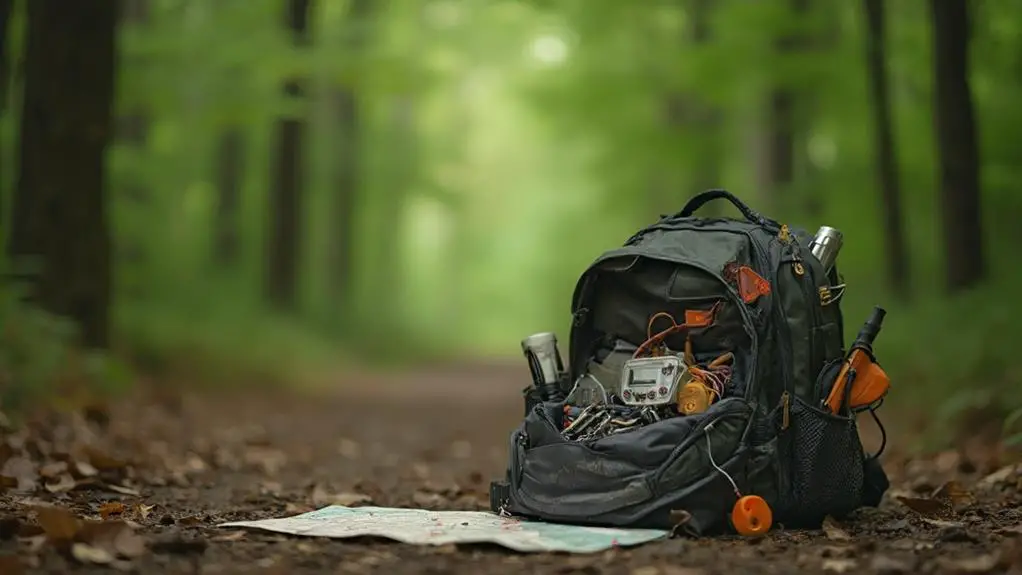
Guaranteeing safety while hiking is paramount, and having the right equipment can greatly enhance your preparedness for unexpected situations. One of the most vital tools is a whistle for safety signals, as it provides a clear means of emergency communication. In distress, three short blasts can alert others to your location, proving more effective than shouting.
A basic first aid kit is non-negotiable, containing essentials like bandages, antiseptic wipes, blister treatments, and pain relievers to address common hiking injuries. This kit allows for prompt treatment, minimizing the impact of minor mishaps.
Additionally, an emergency bivvy or Mylar blanket is invaluable for thermal protection. Lightweight at under 4 ounces and affordably priced around $10, it offers significant warmth and waterproofing without burdening your pack.
Visibility is essential, especially in low-light conditions. A flashlight or headlamp such as the Nitecore NU25, known for its lightweight design and USB-C recharging capability, guarantees you can maneuver safely in the dark.
Weather Preparedness
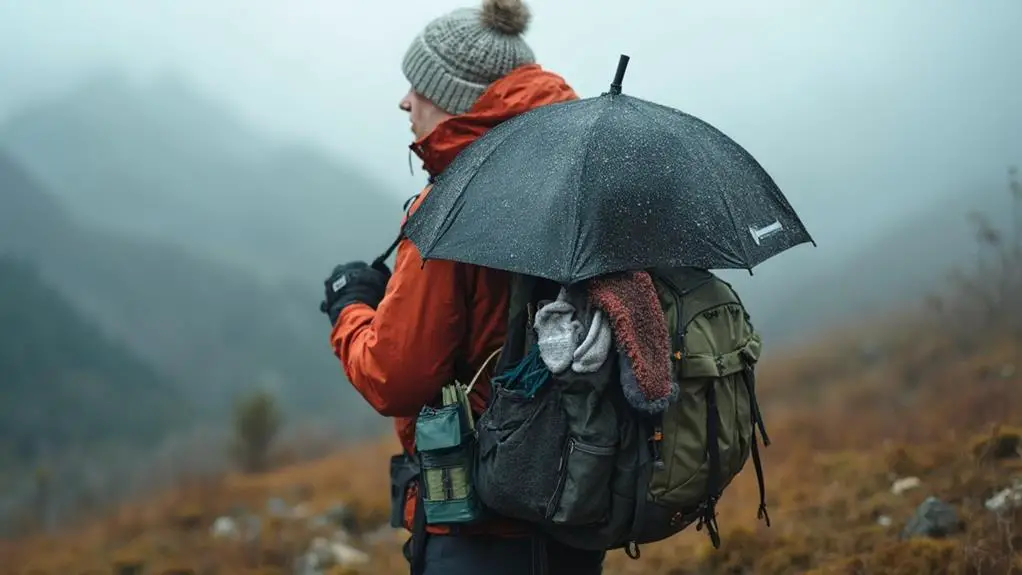
How can hikers best prepare for the unpredictable nature of outdoor weather conditions? Preparation begins with thorough weather forecasting and diligent temperature monitoring. These steps guide clothing and gear decisions. Before setting out, check the forecast to anticipate any sudden changes, such as rain or snow, allowing you to pack accordingly.
Adapting to fluctuating temperatures demands strategic layering. Begin with a moisture-wicking base layer to keep the skin dry, followed by an insulating mid-layer to retain warmth. A waterproof outer layer shields against precipitation, maintaining comfort throughout the hike.
Wind chill can drastically alter perceived temperatures, making windproof jackets or extra insulating layers vital. Consider the following items as indispensable for weather preparedness:
- Layered Clothing: Employ the three-tier system—moisture-wicking base, insulating mid-layer, and waterproof outer layer—to adjust to varying conditions.
- Lightweight, Packable Rain Jacket: Essential for unexpected showers, offering protection without burdening your load.
- Emergency Gear: A mylar blanket provides significant warmth and shelter if caught in adverse conditions.
Cooking and Food Storage
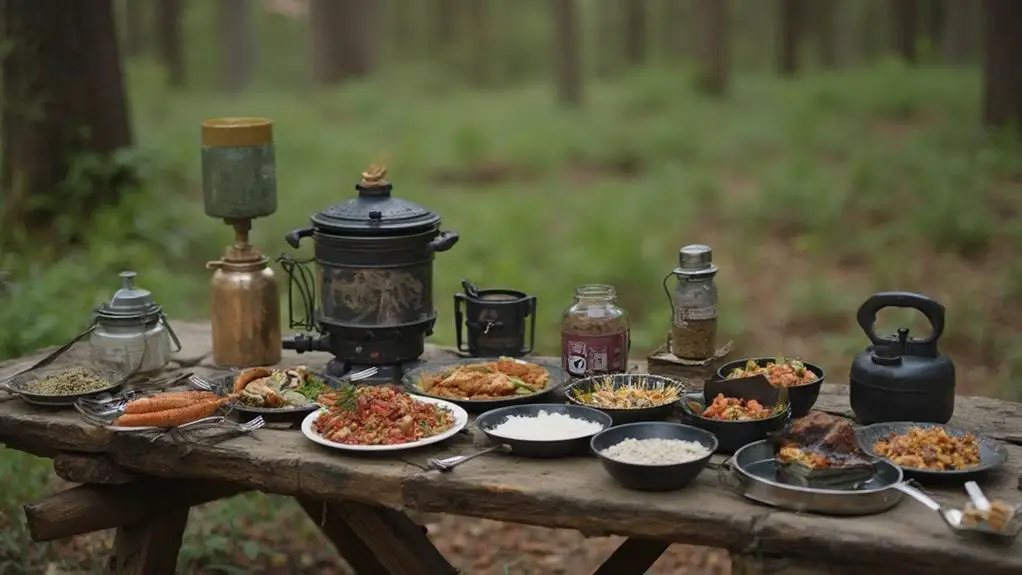
Proper cooking and food storage techniques are vital for any successful hiking expedition, guaranteeing sustenance and safety while out on the trail. Meal prep begins with selecting nutritionally dense snacks like salted nuts, fruits, and energy bars, with options such as Greenbelly meals offering complete nutrition in a compact form. This strategy not only maintains energy levels but also simplifies meal planning.
Portable cooking gear is essential for preparing hot meals and boiling water efficiently. The MSR PocketRocket Deluxe Stove paired with a TOAKS Titanium 750ml Pot provides a lightweight yet effective solution for on-the-go meal prep. This combination allows hikers to enhance their trail nutrition with warm, satisfying meals, which can be vital in maintaining morale and energy.
Food safety is paramount, especially in wildlife-prone areas. Durable food storage solutions like the Backpacker Cache or Ursack AllMitey are designed to protect your provisions from animals, guaranteeing a clean and secure campsite.
Equally important is water purification; using devices like the Sawyer Squeeze Water Filter or water treatment tablets guarantees access to safe drinking water. Complementing these tools are hydration systems, such as Osprey 3L bladders, to maintain proper fluid intake during hikes.
Post-Hike Recovery

As the demands of the trail leave hikers yearning for rest, attention shifts from the logistical challenges of cooking and food storage to the equally important phase of post-hike recovery.
Effective recovery techniques can notably mitigate muscle soreness and enhance overall well-being. Here are three key strategies to optimize recovery:
1. Foam Rolling and Massage Tools: Utilizing devices such as the Trigger Point Performance GRID X Foam Roller can play a significant role in reducing muscle soreness. These tools help release tension and improve flexibility by targeting tight muscle groups.
Similarly, incorporating the Pro-Tec Athletics Spiky Ball Massage Ball can provide targeted relief to specific areas, promoting quicker recovery.
2. Hydration and Nutrition: Replenishing lost fluids and electrolytes is essential post-hike. NUUN Active Tabs offer a convenient solution, delivering a balanced mix of minerals essential for recovery.
Additionally, consuming nutrient-rich snacks like salted nuts or Muir Energy Gels immediately after hiking can replenish energy reserves and support muscle repair.
3. Rest and Recuperation: Integrating rest days into your hiking routine is fundamental. Allowing muscles time to heal prevents overuse injuries and prepares the body for future adventures, ensuring sustained performance and enjoyment on the trails.
Travel and Packing Tips
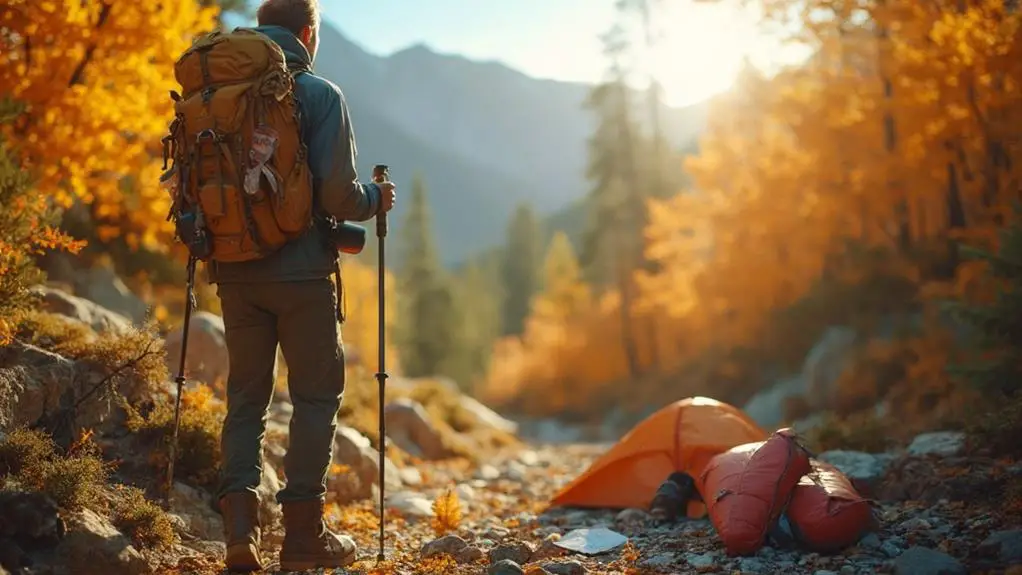
Packing efficiently for a hike is vital to secure a safe and enjoyable outdoor experience. Effective packing techniques and gear organization are essential for maintaining comfort and preparedness on the trail. Begin by utilizing a checklist to confirm all necessary items are included, such as food, water, clothing, first aid supplies, and navigation tools. Selecting the right backpack size is pivotal; a daypack of 10-20 liters suffices for short hikes, while a 70-liter pack is suitable for multi-day adventures.
| Item | Recommended Packing Method |
|---|---|
| Clothing | Lightweight, layered |
| Food & Snacks | Resealable bags or packing cubes |
| First Aid Kit | Easily accessible, compact |
| Navigation Tools | Secure in a side pocket |
Consider the weight and size of your gear to enhance comfort; lightweight options like the Osprey Hikelite 26 can greatly improve your experience. Packing cubes or resealable bags facilitate gear organization, confirming that smaller items like snacks and first aid supplies are easily accessible. Always carry extra layers and snacks, as weather conditions can change unexpectedly, and additional food boosts energy levels. With these strategies, your hike will be both efficient and enjoyable, setting the stage for a successful outdoor adventure.
Frequently Asked Questions
What Hiking Gear Is Essential?
For maximum hiking safety and comfort, invest in quality hiking footwear for support and traction, and reliable navigation tools like a compass and maps. These essentials guarantee preparedness, especially in unfamiliar terrains, enhancing overall outdoor experience and safety.
What Do You Need for Your First Hike?
For your first hike, prioritize safety with proper footwear, hydration, and layers. Adhere to trail etiquette by yielding to uphill hikers and minimizing noise. Equip a first aid kit and understand basic navigation skills for enhanced hiking safety.
What Is a Good First Aid Kit for Hiking?
A good first aid kit for hiking should prioritize wound care and emergency supplies, including adhesive bandages, antiseptic wipes, gauze pads, and pain relief medication. Regularly update the kit with essentials like blister treatments, allergy medications, and water purification options.
What Is Something a Hiker Should Always Have Before Going on His First Hike?
Before starting a first hike, one must prioritize hiking safety tips by carrying essential navigation tools such as a detailed map and compass. These items guarantee effective route planning and safe travel through unfamiliar terrain.
Conclusion
Ultimately, successful hiking necessitates careful selection of essential gear, encompassing navigation tools, appropriate clothing, and suitable footwear to guarantee safety and comfort. Adequate hydration and nutrition are crucial for maintaining energy levels, while weather preparedness safeguards against unpredictable conditions. Cooking and food storage solutions facilitate extended excursions, and post-hike recovery practices promote physical well-being. Meticulous travel and packing strategies further enhance the hiking experience. Mastery of these elements contributes to a rewarding and sustainable engagement with hiking activities.